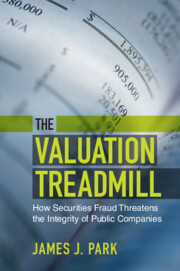Book contents
- The Valuation Treadmill
- The Valuation Treadmill
- Copyright page
- Dedication
- Contents
- Acknowledgments
- 1 Introduction
- 2 Xerox and the Pressure to Meet Projections
- 3 Penn Central and the Decline of Managerialism
- 4 Apple and the Controversy of Projections Litigation
- 5 Enron and Sarbanes–Oxley
- 6 Citigroup and the Financial Crisis of 2008
- 7 General Electric and the Problem of Earnings Management
- 8 The Future of Securities Fraud Regulation
- 9 Conclusion
- Notes
- Index
1 - Introduction
Published online by Cambridge University Press: 14 July 2022
- The Valuation Treadmill
- The Valuation Treadmill
- Copyright page
- Dedication
- Contents
- Acknowledgments
- 1 Introduction
- 2 Xerox and the Pressure to Meet Projections
- 3 Penn Central and the Decline of Managerialism
- 4 Apple and the Controversy of Projections Litigation
- 5 Enron and Sarbanes–Oxley
- 6 Citigroup and the Financial Crisis of 2008
- 7 General Electric and the Problem of Earnings Management
- 8 The Future of Securities Fraud Regulation
- 9 Conclusion
- Notes
- Index
Summary
At some point, it becomes almost impossible for management to deliver on accelerating expectations without faltering, just as anyone would eventually stumble on a treadmill that keeps moving faster. McKinsey & Co., Valuation: Measuring and Managing the Value of Companies, 2020 The typical public corporation now runs on a valuation treadmill. If its stock is traded widely in public markets, it must take care to keep pace with market expectations. Whether it be through developing transformative new products or consistently meeting quarterly financial projections, a public company must continually convince investors that it will generate profits in future years just to maintain its stock price. If investors become concerned that a company’s profitability is declining, they can drastically readjust its valuation.
- Type
- Chapter
- Information
- The Valuation TreadmillHow Securities Fraud Threatens the Integrity of Public Companies, pp. 1 - 12Publisher: Cambridge University PressPrint publication year: 2022

